¶ Introduction
Visual manoeuvring (or circling) is the term used to describe the phase of flight after an instrument approach which brings the aircraft into position for landing on a runway which is not suitably located for straight-in approach or where the criteria for alignment or descent gradient cannot be met.
Circling is not applicable for helicopters. The helicopter pilot has to conduct a visual manoeuvre in adequate meteorological conditions to see and avoid obstacles in the vicinity of the final approach and take-off area (FATO).
A circling approach is a visual flight manoeuvre. After a visual contact, the minimum requirement for circling is to maintain visual with the runway environment while established at minimum descent altitude/height (MDA/H).
Descent below the MDA/H should not be made until:
- Visual reference has been established and can be maintained
- The pilot has the landing threshold in sight
- The required obstacle clearance can be maintained
- The aircraft is in a position to carry out a landing
¶ Visual manoeuvring or Circling
A circling approach can be started when entering the visual manoeuvring area
¶ Visual manoeuvring area
The visual manoeuvring area for a circling approach is determined by drawing arcs centred on each runway threshold and joining those arcs with tangent lines.
A visual manoeuvring (circling) approach can be commenced when entering the visual manoeuvring area.
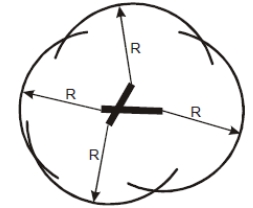
The radius (R) of the arc is related to:
- Category of aircraft
- Airspeed
- Wind speed 25kt
- Bank angle 20° average or 3° per second, whichever requires less bank
| Category of aircraft | A | B | C | D | E |
|---|---|---|---|---|---|
| Maximum speed (kt) | 100 | 135 | 180 | 205 | 240 |
| Maximum true air speed with wind +25kt at 1000ft | 131 | 168 | 215 | 242 | 279 |
| Radius (r) of turn (NM) | 0.69 | 1.13 | 1.85 | 2.34 | 3.12 |
| Straight segment (NM) | 0.30 | 0.40 | 0.50 | 0.60 | 0.70 |
| Radius (R) from threshold (NM) | 1.68 | 2.66 | 4.20 | 5.28 | 6.94 |
Extending downwind beyond visual manoeuvring area is not allowed in order to retain obstacle clearance.
¶ Obstacle clearance
When the visual manoeuvring (circling) has been established, the obstacle clearance altitude/height (OCA/H) is determined for each category of aircraft.
| Aircraft category | Obstacle clearance m (ft) | Lowest OCH above airfield elevation m (ft) | Minimum visibility km (NM) |
|---|---|---|---|
| A | 90 (295) | 120 (394) | 1.9 (1.0) |
| B | 90 (295) | 150 (492) | 2.8 (1.5) |
| C | 120 (394) | 180 (591) | 3.7 (2.0) |
| D | 120 (394) | 210 (689) | 4.6 (2.5) |
| E | 150 (492) | 240 (787) | 6.5 (3.5) |
A procedure can prohibit circling within an entire sector in which a prominent obstacle exists and may be ignored for OCA/H calculation as it is outside the final approach and missed approach areas.
¶ Circling layout
Each circling situation is different because of:
- Runway layout
- Final approach track
- Wind speed
- Meteorological conditions
- Landmarks and obstacles in environment
A typical circling track must contain:
- A track to join the downwind leg
- A downwind leg, except if the aircraft can join and is cleared to join a base leg directly
- A half turn in order to join the final leg, if a downwind leg has been performed
Below we present several track configurations that can be used when performing visual manoeuvring:
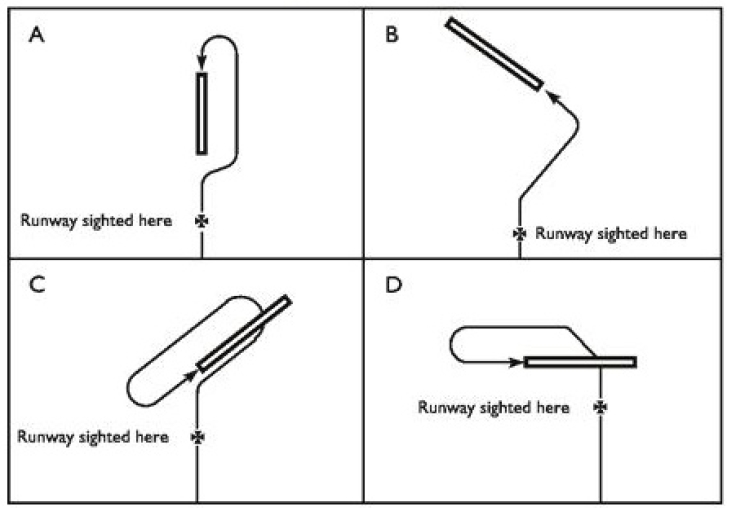
¶ Flown altitude
The visual manoeuvring shall be performed at the MDA altitude (or MDH height) at the minimum.
However, the pilot can choose a higher altitude if the weather conditions so permit. But, the visual manoeuvring and timing must be executed conform to the aircraft specification manual (FCOM) with the aircraft remaining within the visual manoeuvring area. The pilot can choose the normal altitude circuit to perform its visual approach.
¶ Use of Autopilot
Maximum use of autopilot during circling can optimize monitoring of the approach.
Disengaging autopilot shall occur when starting descent below MDA at the latest.
¶ Missed approach procedure
If there is a loss of visual reference (airfield) during the visual manoeuvring, a go around shall be initiated without delay.
The missed approach for the normal instrument procedure applies, but the visual manoeuvring allows for go around and to achieve a safe altitude/height thereafter -- joining the downwind leg of the prescribed track procedure or the instrument missed approach trajectory.
¶ Visual manoeuvring using predefined prescribed tracks
At some airfields, a specified track may be prescribed for visual manoeuvring (VPT) in addition to the circling area. This procedure is based on the aircraft speed category. It is published on a special chart on which the visual features, track description and other characteristics are shown. The direction and the length of each segment are defined.
Navigation is primarily by visual reference and any radio navigation information presented is advisory only.
The missed approach for the normal instrument procedure applies, but the prescribed tracks provide for manoeuvring to allow for go around and to achieve a safe altitude/height thereafter -- joining the downwind leg of the prescribed track procedure or the instrument missed approach trajectory.
If there is a loss of visual reference (airfield) during the visual manoeuvring, a go around shall be initiated without delay.
¶ Standard track
The figure below shows one type of a standard track.
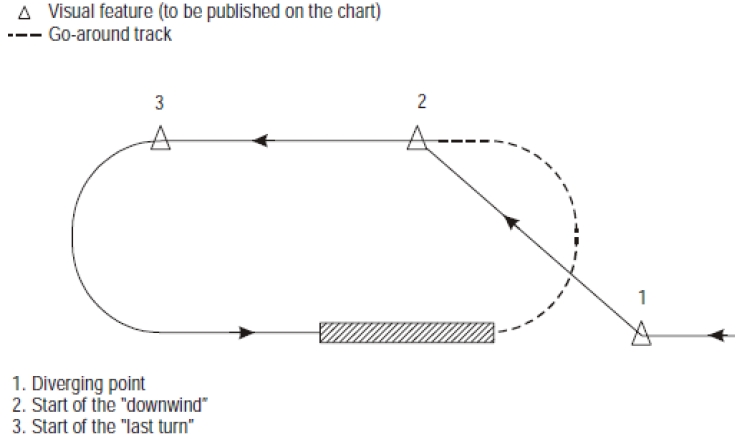
The length of the final segment is based on an allowance of 30s of flight before the threshold.
¶ Common cases of tracks
The common cases of prescribed tracks that you may face are
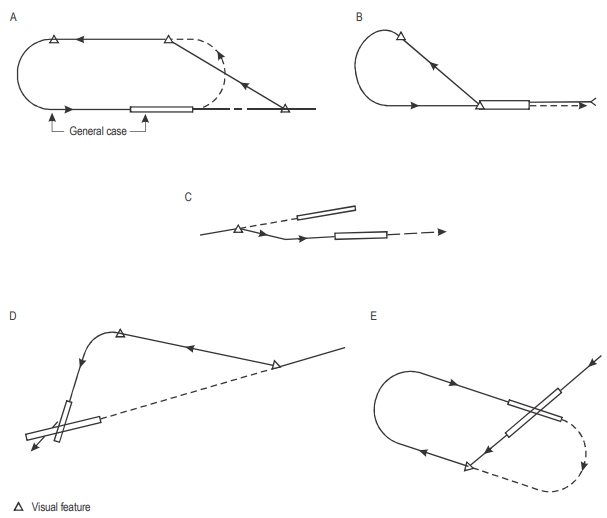
¶ Examples in charts
Due to specific runway configuration or terrain layout, airports can provide other configurations than the standard track.
Example of a special visual manoeuvring using predefined prescribed tracks after an ILS approach:
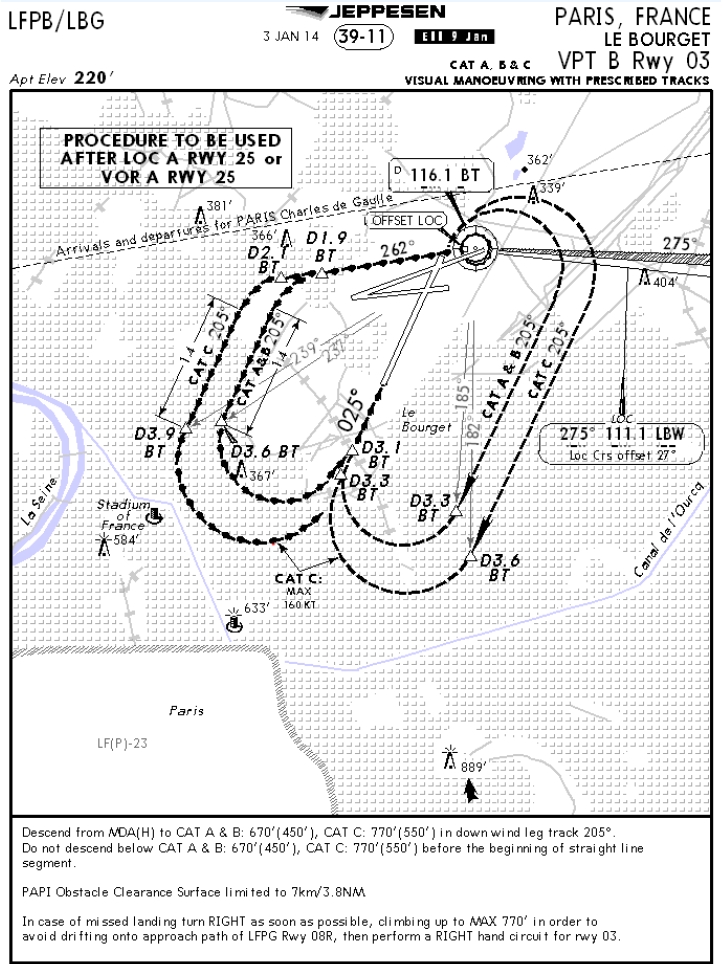
Example of a visual manoeuvring using predefined prescribed tracks directly after IAF:
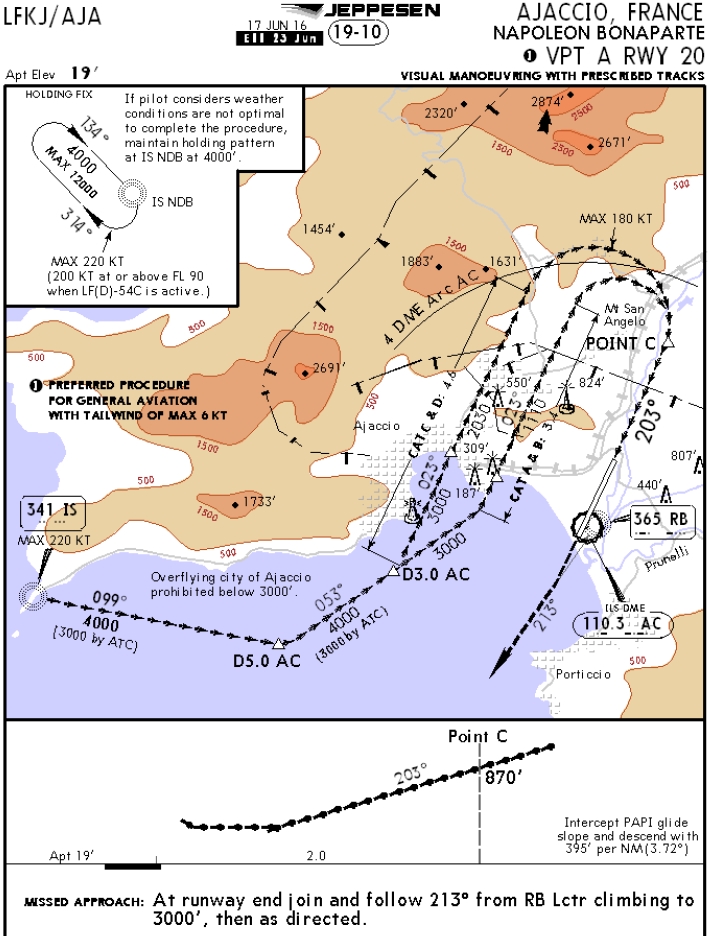
¶ Minimum obstacle clearance (MOC)
The OCA/H for visual manoeuvring on prescribed tracks provides the minimum obstacle clearance (MOC) over the highest obstacle within the prescribed track area.
It also conforms to the limit presented in the table under 'OBSTACLE CLEARANCE' and is not less than the OCA/H calculated for the instrument procedure approach which leads the visual manoeuvre.
¶ Missed approach procedure
If visual reference is lost during visual manoeuvring using predefined prescribed tracks from an instrument approach, the missed approach specified for that particular procedure shall be followed.
The transition from the visual manoeuvre to the missed approach should be initiated by a climbing turn, within the circling area, towards the landing runway, to return to the circling altitude or higher, immediately followed by interception and execution of the missed approach procedure.
The indicated airspeed during these manoeuvres shall not exceed the maximum indicated airspeed associated with visual manoeuvring.
- None
- ICAO Documentation 8168 - Aircraft Operations - Volume II - 6th Edition 2014 - Appendix to Chapter 7
- ICAO Documentation 8168 - Aircraft Operations - Volume I - Flight Procedures - 6th Edition 2010 - Section 4 - Chapter 7
- VID 150259 - Creation
- VID 531824 - Wiki Integration
- VID 150259 - Update September 2019
- VID 496402 - Wiki.js Integration